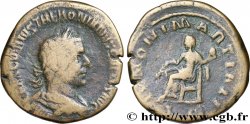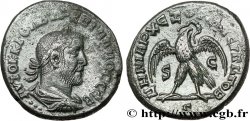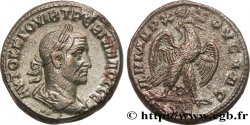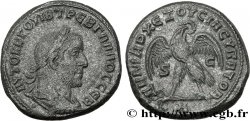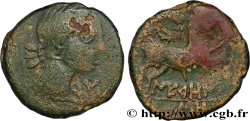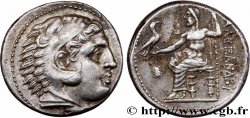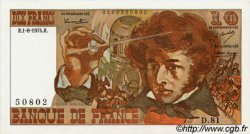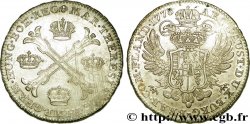bpv_154406 - TREBONIANUS GALLUS Tétradrachme syro-phénicien
Nicht verfügbar.
Artikel auf unserem Online-Shop verkauft (2014)
Preis : 90.00 €
Artikel auf unserem Online-Shop verkauft (2014)
Preis : 90.00 €
Type : Tétradrachme syro-phénicien
Datum: 251
Name der Münzstätte / Stadt : Antioche, Syrie, Séleucie et Piérie
Metall : Scheidemünze
Durchmesser : 28 mm
Stempelstellung : 6 h.
Gewicht : 12,45 g.
Kommentare zum Erhaltungszustand:
Tout étant relatif, belle surface argentée pour cette émission, belle frappe et coins frais, le revers étant moins agréable
N° im Nachschlagewerk :
Pedigree :
Cet exemplaire est le 0662_004 de la base TSP
Vorderseite
Beschreibung Vorderseite Buste lauré, drapé et cuirassé de Trébonien Galle à droite, vu de trois quarts en arrière (A*2), quatre globules sous le buste.
Legende des Averses AUTOK K G OUIB TREB GALLOS SEB
Übersetzung der Vorderseite (Imperator Cæsar Caius Vibius Trebonianus Gallus Augustus).
Rückseite
Titulatur der Rückseite S C À L’EXERGUE.
Beschreibung Rückseite Aigle debout à droite sur une ligne de terre, les ailes déployées, tête et queue à gauche, tenant une couronne feuillée dans son bec, lettre d’officine entre les pattes.
Legende des Reverses : DHMARC EX OUSIAS / D
Übersetzung der Rückseite (Revêtu de la puissance tribunitienne / avec l’accord du Sénat d’Antioche).
Kommentare
Les frappes de Trébonien Galle et de Volusien signent la fin de la série des tétradrachmes syro-phéniciens, si l’on ne tient pas compte du sursaut d’Uranius Antoninus. Cette courte frappe, 251/253, va concentrer tous les symptômes d’une fin, de l’effondrement de l’aloi à celui du style.
Notons tout d’abord les changements de fond : mis à part la complète disparition des bustes radiés qui sont réservés à Volusien, la palme disparaît et la position de l’aigle change.
Que pouvait représenter cette palme ?
Une autorité impliquée dans le financement du monnayage ? Dans ce cas, elle aurait passé les siècles et serait certainement d’essence religieuse puisque sa première apparition est dans la main de la Tyché de la ville. Le culte rendu à cette divinité était-il si important que les autorités auraient pu en mettre le clergé à contribution où requérir son aval ? Si tel est le cas, pourquoi Trébonien Galle aurait-il dérogé à l’habitude ? Pourquoi aurait-elle disparu sous les Sévères ?
On peut aussi penser à un raccourci symbolique de la Tyché mais pourquoi Trébonien aurait-il éliminé cette référence ? La question reste ouverte.
D’autant plus que le changement de position de l’aigle, où tête et queue sont maintenant systématiquement en position inverse du corps, rappelle immanquablement les rarissimes émissions finales de Trajan Dèce et de sa famille avec cette position et le point entre les pattes, remplacé chez Trébonien Galle par la lettre d’atelier. Il faut croire que les changements de type monétaire précèdent, dans l’Antioche du IIIe siècle, les chutes de régime : cela se vérifie de Philippe à Galle.
La première série de frappe est de 251 AD avec un revers sans marque de consulat. Tous les bustes sont laurés, drapés et cuirassés sauf un buste à gauche de la septième officine, le seul buste exceptionnel retrouvé à ce jour. La qualité des frappes et de l’aloi sont comparables aux standards de Trajan Dèce.
On note que les sigma sont gravés en C.
Dans la base TSP maintenue par Michel Prieur, cinquante-deux exemplaires sont maintenant répertoriés pour ce type dont en musées Paris, British Museum, Jérusalem, Doura/Yale (8), ANS(2), Oxford (2), Berlin et Gaziantep.
The strikes of Trebonianus Gallus and Volusianus mark the end of the series of Syro-Phoenician tetradrachms, if we do not take into account the surge of Uranius Antoninus. This short strike, 251/253, will concentrate all the symptoms of an end, from the collapse of the alloy to that of the style..
Let us first note the fundamental changes: apart from the complete disappearance of the radiate busts which are reserved for Volusien, the palm disappears and the position of the eagle changes.
What could this palm represent? An authority involved in financing the coinage? In this case, it would have survived the centuries and would certainly be of religious essence since its first appearance is in the hand of the city's Tyche.. Was the cult of this deity so important that the authorities could have called upon the clergy or sought their approval? If so, why would Trebonianus Gallus have deviated from the custom? Why would it have disappeared under the Severi? One could also think of a symbolic shortcut to Tyche, but why would Trebonianus have eliminated this reference? The question remains open..
All the more so since the change in position of the eagle, where the head and tail are now systematically in the opposite position to the body, inevitably recalls the extremely rare final emissions of Trajan Decius and his family with this position and the point between the legs, replaced in Trebonianus Galle by the workshop letter. It must be believed that changes in monetary type precede, in Antioch of the 3rd century, the falls of regime: this is verified from Philip to Galle.
The first strike series is from 251 AD with a reverse without a consulate mark. All the busts are laureate, draped and cuirassed except for one bust on the left of the seventh office, the only exceptional bust found to date.. The quality of the strikes and the alloy are comparable to the standards of Trajan Decius..
Note that the sigmas are engraved in C.
In the TSP database maintained by Michel Prieur, fifty-two examples are now listed for this type, including in museums in Paris, the British Museum, Jerusalem, Doura/Yale (8), ANS(2), Oxford (2), Berlin and Gaziantep.
Notons tout d’abord les changements de fond : mis à part la complète disparition des bustes radiés qui sont réservés à Volusien, la palme disparaît et la position de l’aigle change.
Que pouvait représenter cette palme ?
Une autorité impliquée dans le financement du monnayage ? Dans ce cas, elle aurait passé les siècles et serait certainement d’essence religieuse puisque sa première apparition est dans la main de la Tyché de la ville. Le culte rendu à cette divinité était-il si important que les autorités auraient pu en mettre le clergé à contribution où requérir son aval ? Si tel est le cas, pourquoi Trébonien Galle aurait-il dérogé à l’habitude ? Pourquoi aurait-elle disparu sous les Sévères ?
On peut aussi penser à un raccourci symbolique de la Tyché mais pourquoi Trébonien aurait-il éliminé cette référence ? La question reste ouverte.
D’autant plus que le changement de position de l’aigle, où tête et queue sont maintenant systématiquement en position inverse du corps, rappelle immanquablement les rarissimes émissions finales de Trajan Dèce et de sa famille avec cette position et le point entre les pattes, remplacé chez Trébonien Galle par la lettre d’atelier. Il faut croire que les changements de type monétaire précèdent, dans l’Antioche du IIIe siècle, les chutes de régime : cela se vérifie de Philippe à Galle.
La première série de frappe est de 251 AD avec un revers sans marque de consulat. Tous les bustes sont laurés, drapés et cuirassés sauf un buste à gauche de la septième officine, le seul buste exceptionnel retrouvé à ce jour. La qualité des frappes et de l’aloi sont comparables aux standards de Trajan Dèce.
On note que les sigma sont gravés en C.
Dans la base TSP maintenue par Michel Prieur, cinquante-deux exemplaires sont maintenant répertoriés pour ce type dont en musées Paris, British Museum, Jérusalem, Doura/Yale (8), ANS(2), Oxford (2), Berlin et Gaziantep.
The strikes of Trebonianus Gallus and Volusianus mark the end of the series of Syro-Phoenician tetradrachms, if we do not take into account the surge of Uranius Antoninus. This short strike, 251/253, will concentrate all the symptoms of an end, from the collapse of the alloy to that of the style..
Let us first note the fundamental changes: apart from the complete disappearance of the radiate busts which are reserved for Volusien, the palm disappears and the position of the eagle changes.
What could this palm represent? An authority involved in financing the coinage? In this case, it would have survived the centuries and would certainly be of religious essence since its first appearance is in the hand of the city's Tyche.. Was the cult of this deity so important that the authorities could have called upon the clergy or sought their approval? If so, why would Trebonianus Gallus have deviated from the custom? Why would it have disappeared under the Severi? One could also think of a symbolic shortcut to Tyche, but why would Trebonianus have eliminated this reference? The question remains open..
All the more so since the change in position of the eagle, where the head and tail are now systematically in the opposite position to the body, inevitably recalls the extremely rare final emissions of Trajan Decius and his family with this position and the point between the legs, replaced in Trebonianus Galle by the workshop letter. It must be believed that changes in monetary type precede, in Antioch of the 3rd century, the falls of regime: this is verified from Philip to Galle.
The first strike series is from 251 AD with a reverse without a consulate mark. All the busts are laureate, draped and cuirassed except for one bust on the left of the seventh office, the only exceptional bust found to date.. The quality of the strikes and the alloy are comparable to the standards of Trajan Decius..
Note that the sigmas are engraved in C.
In the TSP database maintained by Michel Prieur, fifty-two examples are now listed for this type, including in museums in Paris, the British Museum, Jerusalem, Doura/Yale (8), ANS(2), Oxford (2), Berlin and Gaziantep.








 Berichten über einen Fehler
Berichten über einen Fehler Die Seite drucken
Die Seite drucken Teilen meiner Auswahl
Teilen meiner Auswahl Stellen Sie eine Frage
Stellen Sie eine Frage Einlieferung/Verkauf
Einlieferung/Verkauf
 Details
Details